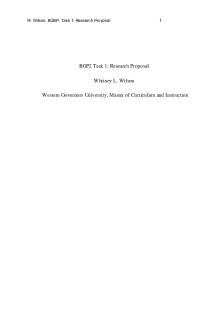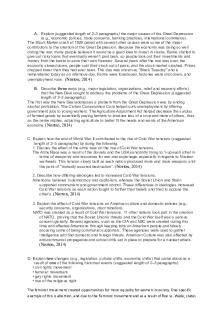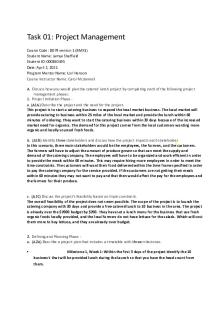Task 1 D091 done - Passed PDF

| Title | Task 1 D091 done - Passed |
|---|---|
| Author | Ashley McClendon |
| Course | Introduction to Curriculum, Instruction, and Assessment |
| Institution | Western Governors University |
| Pages | 6 |
| File Size | 139.4 KB |
| File Type | |
| Total Downloads | 48 |
| Total Views | 146 |
Summary
Passed...
Description
Ashley McClendon D091- Introduction to curriculum, instruction, and assessment A. Case number 191 is formative assessment video 3 is what I selected for my first video. This video is named Using images to build speaking, listening, and descriptive language skills. Video link, https://lrps.wgu.edu/provision/191619788. Description A1. Two modifications that the teachers make right off is the student she has that needs redirection in class often, and one of her student who has health conditions that require the lesson to be slowed down so she can comprehend the material. The teachers’ goal of the day was to get her kids to “1) speak in complete sentences using vocabulary related to the topic while viewing pictures, 2) to take turns listening and speaking, and 3) to speak clearly and at an appropriate pace considering the audience.” (Case number 191) The lesson is This lesson is” part of a tenday instructional unit about whales and their physical features and adaptations for survival.” (Case number 191), using formative assessment. As she was talking about the lesson, she realized some of her kids did not know whales, once she realized this, she modified her lesson to build on what others knew and build background knowledge. She let the kids pair up and used this to let the kids ask each other questions, relate, and build this is called think-pair-share with peers. When this was done, she went around the room and let the kids tell her descriptive sentences and vocabulary words. This lets the students assess each other and then themselves in the center group work. She wrote this on a sticky note to give an example of what the kids would also be doing. The teacher used example-based instruction and build off the student’s background knowledge. She let them talk at their pace and made sure each respected the other while doing so. Feelings A2. In the video, it was clear some of the students were struggling to understand what the teacher wanted from them in this lesson. I could not see all the children on the camera, but it was clear when he tried to correct the teacher that he already knew what he was looking at and confident in the lesson. Some of the students did not understand the point of the sticky notes or did not understand the instruction. The young male student who did not understand the point of the sticky note, the respect however was clear, because when he asked his question and was not scared to. When she explained and restated the use of the sticky note and started to use it herself the male student understood. This was clear because he was engaged back in the lesson and seemed excited to continue. Another student was a female student who seemed to be struggling with the lesson, she was fidgeting around and seemed interested in everything, but the lesson. When the teacher asked if there was any question the female student Sarah did ask what had been bothering her. The other students quieted down and let her ask. When she asked the questions, she also answered it the teacher encouraged her and told her “Exactly, exactly, exactly” (case number 91), building the student’s confidence. Once she understood what was going to be excepted, she seemed to also get more engaged and interested in the lesson. Evaluation
A3. The effectiveness of the adjustments was clear when each student became engaged. In the group on the carpet, they were engaged and respectively repeating what the other said when it was their turn to do so. In the group center work, they all seemed engaged and excited, and this happens when the kids understand the material. I think when the teacher gave examples and displayed how to use the tools, they were given the student had to moment of understanding the best. The kids stayed on task and used the recording devices to correct themselves in the way there were talking. This teacher uses every possible route she must give her students a better chance at learning. She uses student-to-student learning the most in this lesson. Analysis A4. The teacher made these changes to her lesson, to make sure her students understand the material. She asked many times if anyone had questions and answered them thoroughly. She does not move on without making sure kids understand and uses many examples The teacher used background knowledge to build upon with her kids she understands Gibb’s cycle and that not every kid learns the same. She uses think-pair-share groups for the kids to build from each other and formative assessment in the group work to see if the kids have understood the lesson and where she may need to improve the lesson in the future. Conclusion A5. Formative assessments can be used for data the best because it gives clear instructions to the students, and it lets her makes easy modifications to the lesson. If the students do not understand she can easily alter something so they can. Teachers need to spend more time teaching and reflecting, and this assessment allows them that time. The Gibbs cycle is also clearer to see in the formative assessment, an example of how the cycle is “1 concrete experience, 2 reflective observation, 3 abstract conceptualization, 4 active experimentation” (Gibbs G. 1988). Action A6. I would use the group sharing ideas as this teacher did, I think this gives the kids a chance to ask more questions they may not want to ask in front of everyone. It gives them a chance to learn about each other and build off that background knowledge. I would also use the way she gave examples and encouraged the kids to build off that. I think showing the kids exactly what she expected out of each group gave them goals to drive toward and they knew what they were supposed to do. This would benefit me in a classroom because it would build the expectations of the lesson and keep repeated questions from happening. B. Case number 1355, video 2 about differentiation, video 3. This video is demonstrating map skills through hands-on and creative activities. Video link, https://lrps.wgu.edu/provision/191619875 Description B1. This teacher has many students in her class that have IEP’s, they are mentally delayed, and behavior issues. However, she does seem to pay close attention to this and what they enjoy helping lead her lessons. An example of differentiating learning that she displays is “The goal was to demonstrate their map skills and understanding of map features through a final
project of the student's choice of a song, a play, or a PowerPoint presentation. I chose this goal due to a class survey that indicated many of my students were interested in songs, plays, and technology.” (Case number 1355). One of her students is an English learner and she differentiates how he learns by using “the SIOP (Sheltered Instruction Observation Protocol) model for all students to make 4-corners to comprehend the vocabulary words. We then found places on a map, located natural and cultural /physical features on a map, and ended the unit measuring distances in inches on a map (map scale).” (Case number 1355). Another way she lets all the students learn how they want is by giving them an option to work alone or in groups, she can do this because she pays attention to how her kids learn or work. They get to choose the group and she gives them step-by-step directions to help them stay goal orientated and driven to finish. Feelings B2. There was one student’s feelings who were clear and one group where their feelings were clear. The rest seemed to participate well together and ask questions when needed, they worked well in the group activities of their choice. Asiyah choose to work alone and work on a PowerPoint, during she became slightly discouraged because she does not understand the stepby-step directions, the teacher helps her through this, and her PowerPoint is completed. She then takes pride in her work and gets confidence from working alone and getting praise for her accomplishments. Group 6 that comes off task is because they are confused when the teacher asks more in-depth questions about their college. They become frustrated and she helps them by referencing the book, that they can look at it and find the answers. This encourages them to use the materials at hand and be able to answer the question that the teacher asks. Evaluation. B3. The effectiveness of differentiation this teacher uses is clear by the end of the class when each student is still happily engaged in their group and finishes their work. Class disruption is kept low, and the children work happily together. In the group area’s each kid takes a job, and they work on their project together. She made sure to have a group for each of her kids' interests that keep them engaged and they learn from it. One of the main purposes she does this map lesson is because when one of her kids brought a map from a theme park, she noticed many kids did not understand how the map worked. So, using this interest she built off it with her lessons since the kids were excited to understand it was easier to keep them engaged. This is also a standard on her curriculum so while they are learning and retaining, she is benefitting by how she is teaching the lesson because they retain the knowledge better. Analysis B4. The teacher used differentiated instruction by giving the class a whole option to how they would present their knowledge. Every group the teacher created will give her an idea of where each one of the kids is at, she can use this in many ways like reviewing and seeing where she can improve. One skill she wanted her kids to learn was interacting with each other and showing good respectful teamwork. They did display this and at the end of the class she used formative and informal assessments to see where the kids were at over eight five percent of her kids could not read a map. Learning context that could influence those decisions was that she
placed her students with other students who would involve them and in groups that they would love what they were doing. An example to show this was all displayed is “There was collaboration and teamwork not just during the video segment but throughout the entire unit. Students interacted with each other in their group discussions, acknowledged the viewpoints of their group members, and/or agreed with others. My efforts to help the students understand the social skills/concept and the art skill/concept were successful. By using the arts in this lesson, I noticed that my students were more focused and engaged in learning.” (Case number 1355) Conclusion B5. As the Gibbs cycle states and differentiating learning is explained each student learns in their way, and when a teacher can figure out how each of her kids learns it allows for the class to accelerate and learn quicker. There is always room for improvement with lessons, but a teacher like the one in the video spent one lesson and because she knew how her kids learned was able to improve them from fifty percent knowing to eighty-five percent. This teacher used 4 rules out of the differentiating learning that is vital to student learning, “Using spelling or vocabulary lists at readiness levels of students; 2. Presenting ideas through both auditory and visual means; 3. Using reading buddies; and 4. Meeting with small groups to re-teach an idea or skill for struggling learners, or to extend the thinking or skills of advanced learners.” (Tomlinson C.A, 2000) Action B6. Two strategies that I determined from this video that I will use in my teaching, are the differentiating assignments she offered the students. I want to know my kids as well as she knows hers. An to be able to place them in groups where they will succeed. Meeting the demands of my students is what will help them become functioning students who love to learn and do not get discouraged by things they do not understand. Her kids in one group started to get discouraged, but she referenced them back to the book and encourages them to look it up. The second thing I would use is technology, because as time goes on most kids learn better with the computer or audio played to them. The student who uses PowerPoint to display her knowledge can put as many pictures and examples as she wants. Giving this child a chance to express herself and build confidence. C. Explain how teachers use formative assessment and differentiation together: Using formative assessments and differentiation learning helps a teacher know where each student is and how each student can learn. She alters each task to how the work can be complete to get the same understanding from each student. Facts from video A that showed formative assessment and differentiation together was at the beginning of class when the kids did not remember the vocabulary words and were very confused about what to do. She used a formative assessment to determine where she needed to improve her teaching next time and now knew to give explicit instruction. She did this by showing the use of the sticky note and letting the kids use group sharing to build on knowledge. Differentiating was shown in group work where the students went around the room to different stations unique to how each learned. Some had audio recordings in their hands, and she had stations where they could put headphones on. Facts from video B for showing formative assessment was when she had each student go over
their project and take a test at the end to see where each student was, that was where the eightyfive percent increase came from in topic B4. The differentiating learning also was proven to work by the formative assessment showing that kids can learn new material. Kids all learn in different ways.
D. Works citied:
Gibbs, G. (1988). Learning by doing: A guide to teaching and learning methods. Oxford Brookes University.
Tomlinson, C. A. (2000, August). What is differentiated instruction? Retrieved from https://www.readingrockets.org/article/what-differentiated-instruction...
Similar Free PDFs

Task 1 D091 done - Passed
- 6 Pages

TAT2 Task 1: Passed
- 14 Pages

C227 Task 1 - Passed Task
- 22 Pages

D082 Task 1- PASSED
- 2 Pages

C206 Task 1 V2 - Task 1 Passed.
- 11 Pages

D095 Task 1 passed WGU
- 3 Pages

Task2 - Task 2: Passed
- 3 Pages

C225 Task 2 (passed)
- 8 Pages

History task 4 - PAssed
- 2 Pages

C200 Task 2 - Passed
- 13 Pages
Popular Institutions
- Tinajero National High School - Annex
- Politeknik Caltex Riau
- Yokohama City University
- SGT University
- University of Al-Qadisiyah
- Divine Word College of Vigan
- Techniek College Rotterdam
- Universidade de Santiago
- Universiti Teknologi MARA Cawangan Johor Kampus Pasir Gudang
- Poltekkes Kemenkes Yogyakarta
- Baguio City National High School
- Colegio san marcos
- preparatoria uno
- Centro de Bachillerato Tecnológico Industrial y de Servicios No. 107
- Dalian Maritime University
- Quang Trung Secondary School
- Colegio Tecnológico en Informática
- Corporación Regional de Educación Superior
- Grupo CEDVA
- Dar Al Uloom University
- Centro de Estudios Preuniversitarios de la Universidad Nacional de Ingeniería
- 上智大学
- Aakash International School, Nuna Majara
- San Felipe Neri Catholic School
- Kang Chiao International School - New Taipei City
- Misamis Occidental National High School
- Institución Educativa Escuela Normal Juan Ladrilleros
- Kolehiyo ng Pantukan
- Batanes State College
- Instituto Continental
- Sekolah Menengah Kejuruan Kesehatan Kaltara (Tarakan)
- Colegio de La Inmaculada Concepcion - Cebu





